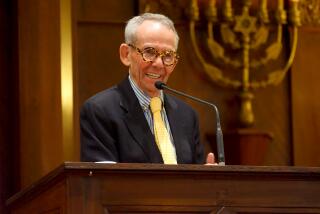Book Review : Reading Between the Lines of Wallace Stevens
Wallace Stevens: The Later Years, 1923-1955 by Joan Richardson (Morrow/Beech Tree Books: $24.95, 544 pages)
“Oh, blessed rage for order . . . / The maker’s rage to order words of the sea. . . .”
A blessed rage for order nicely characterizes the life of Wallace Stevens, an insurance company lawyer who wrote some of the most distinguished poetry of the 20th Century, including the much-anthologized “The Idea of Order at Key West” (quoted above), “The Emperor of Ice Cream,” “The Man With the Blue Guitar,” “Le Monocle de Mon Oncle.” The order that Wallace Stevens imposed on his own life was literally “monk-like.”
“He established spheres of order in which he moved in the way monks move through their days, weeks and months,” Joan Richardson writes in “Wallace Stevens: The Later Years,” the newly published second volume of her authoritative two-volume biography of the poet. “His poems were like devotions, composed in the mornings in rhythm to his breath and step as he walked to the office.”
The biographical and critical narrative of Richardson’s new book follows seamlessly from the first volume, “Wallace Stevens, a Biography: The Early Years, 1879-1923” (Morrow/Beech Tree: $21.95, 592 pages). Together, these two volumes constitute a definitive biography of Wallace Stevens, and an intellectual and literary history of the United States in the first half of the 20th Century.
Puzzling Question
The “central intrigue” of Stevens’ life, Richardson suggests, is the contrast between the poet and the “money-making lawyer”--a distinction that Stevens himself rigidly maintained. “Why would a man who was considered the dean of surety claims in the country,” Richardson muses in her introduction to the first volume, “be afraid that he would be laughed at by an audience assembled to honor him with an award for his poetry, or be afraid, too, that he might lose his job as vice president of the insurance company where he had been employed for almost 40 years were he not to be at his desk every day?”
Richardson, who brings an impressive mastery of biographical and literary source materials to her work, presents the life of Wallace Stevens as a war between “the rational and the irrational,” between the staid insurance lawyer and the accomplished man of letters. Somehow, Richardson suggests, Stevens was able “to transform the Puritan values with which he had been reared into a set of qualities that nurtured instead of starved his spirit.”
By “applying his ideas of order to everyday life,” she writes, “he could safely yield to poetry’s disorder.”
It’s hard not to see Stevens as aloof, cautious, rigid. Richardson struggles to show us evidence of some greater stirrings of the spirit and the imagination than one would expect from “the dean of surety claims.” She describes Stevens as “a modern mock Candide,” “a naive socialist,” “a comedian.” She recounts the celebrated story of a drunken brawl between Stevens and Ernest Hemingway at a Key West cocktail party--but she reveals, too, that Stevens contrived to conceal his injury as the result of an accidental fall “lest his insurance company colleagues get wind of it.”
Explaining the Remarks
So the man who emerges from Richardson’s biography is hardly lovable or even laudable. Stevens, whose poetry was elegant and cerebral, once remarked that “the Italians have as much right to take Ethiopia from the coons as the coons had to take it from the boa-constrictors.” Later, the courtly Yankee lawyer declined to speak at a memorial service for Dylan Thomas, claiming to be uneasy at public speaking but privately explaining that he found Thomas to be “an utterly improvident person.”
Stevens tried to explain away some of his most repugnant remarks, and Richardson--a sympathetic biographer--joins in the effort: “Such statements were meant to elicit questioning responses,” she insists gamely. “One who did not respond, but who simply took one of these statements as fact, failed to enter into the essentially human relationship--the dialogue on which all directed change is based.”
Similarly, we are shown the stresses and strains of Stevens’ long marriage to a reclusive and unstable woman--Stevens helped with the housework, Richardson explains, because his wife drove away the hired help.
Author’s Scholarship
Yet Richardson makes light of an extraordinarily constricting relationship: “Living with her must have been something like living with Gracie Allen,” Richardson writes of Elsie Stevens. “An avid admirer of Groucho Marx, Jack Benny, George Burns and Bob Hope, Stevens must have chuckled to himself often.”
Richardson’s work is dense with the author’s scholarship, rich with her insight and wholly praise-worthy. But, as a reader who came to the biography with an affection and respect for the poetry of Wallace Stevens, I am afraid that I found out more than I wanted to know about the poet. As with T. S. Eliot--a contemporary of Wallace Stevens who also made a living in business, and who was also capable of elitism and even bigotry--I found myself wondering if I could ever love the man’s poetry as much as I did before I learned about the man himself.
More to Read
Sign up for our Book Club newsletter
Get the latest news, events and more from the Los Angeles Times Book Club, and help us get L.A. reading and talking.
You may occasionally receive promotional content from the Los Angeles Times.






